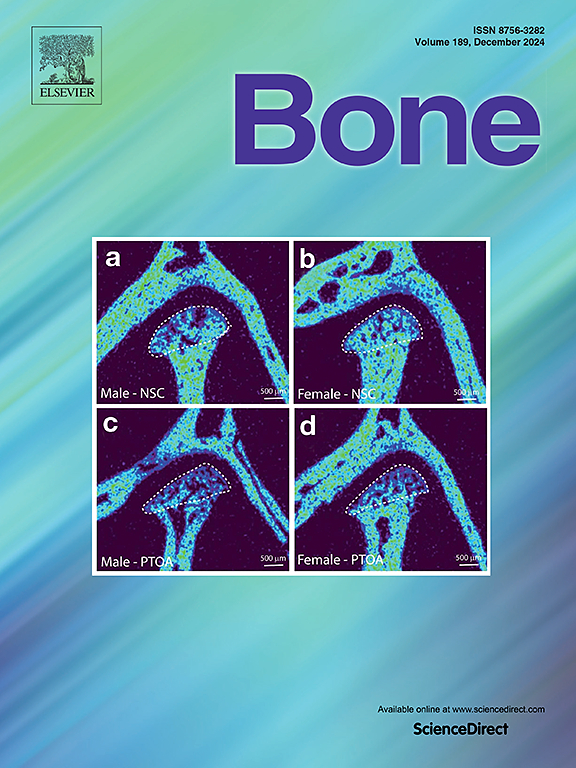Col1a2oim/oim mice exhibit alterations in ossicular bone quality typical of osteogenesis imperfecta but no hearing loss
IF 3.6
2区 医学
Q2 ENDOCRINOLOGY & METABOLISM
引用次数: 0
Abstract
Osteogenesis imperfecta (OI) is an inherited connective tissue disorder clinically mainly characterized by skeletal fragility. However, non-skeletal manifestations, some of which do not appear until adulthood, can additionally severely impact the health and quality of life of the affected patients. These include hearing loss that is observed in approximately every second OI patient. While the hearing loss in OI is mainly due to impaired sound transmission (i.e., conductive hearing loss), the underlying mechanisms are currently elusive. Here, we investigated the Oim (Col1a2oim/oim) mouse model of classical OI, focusing on bone quality features of the middle ear and hearing function. No osseous morphological changes were observed in the middle or inner ear of male Col1a2oim/oim mice compared to wildtype controls. Backscattered electron imaging and Fourier-transform infrared spectroscopy revealed increased matrix mineralization and matrix maturity of the auditory ossicles (malleus, stapes). These changes have previously been described as typical features of OI in other skeletal regions. However, measurement of auditory function by auditory brainstem response revealed no gross hearing pathology and even indicated a slightly improved hearing ability in Col1a2oim/oim mice in the 32 kHz range as determined by distortion product otoacoustic emissions (DPOAEs). Taken together, our results indicate that the conductive hearing loss observed in classical OI is not due to the altered bone quality of the middle ear, at least under unchallenged conditions in mice.
col1a2im /oim小鼠表现出典型成骨不全的听骨质量改变,但没有听力损失
成骨不全症(Osteogenesis imperfecta, OI)是一种遗传性结缔组织疾病,临床主要表现为骨骼脆弱。然而,非骨骼表现,其中一些直到成年才出现,可能会严重影响受影响患者的健康和生活质量。其中包括大约每秒钟就有一例成骨不全症患者出现听力损失。虽然成骨不全患者的听力损失主要是由于声音传输受损(即传导性听力损失),但其潜在机制目前尚不清楚。在此,我们研究了Oim (col1a2im / Oim)小鼠经典OI模型,重点研究中耳骨质量特征和听力功能。与野生型对照组相比,雄性col1a2im /oim小鼠中耳和内耳未见骨形态学改变。背散射电子成像和傅里叶变换红外光谱显示听骨(锤骨、镫骨)基质矿化和基质成熟度增加。这些变化以前被描述为其他骨骼区域成骨不全的典型特征。然而,通过听觉脑干反应测量听觉功能显示,col1a2im /oim小鼠在32 kHz范围内的听觉功能没有明显的听觉病理,甚至在畸变积耳声发射(dpoae)中显示听力略有改善。综上所述,我们的研究结果表明,在典型成骨不全中观察到的传导性听力损失不是由于中耳骨质量的改变,至少在小鼠的无挑战条件下是这样。
本文章由计算机程序翻译,如有差异,请以英文原文为准。
求助全文
约1分钟内获得全文
求助全文
来源期刊

Bone
医学-内分泌学与代谢
CiteScore
8.90
自引率
4.90%
发文量
264
审稿时长
30 days
期刊介绍:
BONE is an interdisciplinary forum for the rapid publication of original articles and reviews on basic, translational, and clinical aspects of bone and mineral metabolism. The Journal also encourages submissions related to interactions of bone with other organ systems, including cartilage, endocrine, muscle, fat, neural, vascular, gastrointestinal, hematopoietic, and immune systems. Particular attention is placed on the application of experimental studies to clinical practice.
 求助内容:
求助内容: 应助结果提醒方式:
应助结果提醒方式:


